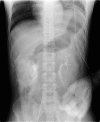Bilateral ureteropelvic disruption following blunt abdominal trauma: case report
- PMID: 21733189
- PMCID: PMC3161023
- DOI: 10.1186/1471-2490-11-14
Bilateral ureteropelvic disruption following blunt abdominal trauma: case report
Abstract
Background: Ureteral injury occurs in less than 1% of blunt abdominal trauma cases, partly because the ureters are relatively well protected in the retroperitoneum. Bilateral ureteral injury is extremely rare, with only 10 previously reported cases. Diagnosis may be delayed if ureteric injury is not suspected, and delay of 36 hours or longer has been observed in more than 50% of patients with ureteric injury following abdominal trauma, leading to increased morbidity.
Case presentation: A 29-year-old man was involved in a highway motor vehicle collision and was ejected from the front passenger seat even though wearing a seatbelt. He was in a preshock state at the scene of the accident. An intravenous line and left thoracic drain were inserted, and he was transported to our hospital by helicopter. Whole-body, contrast-enhanced computed tomography (CT) scan showed left diaphragmatic disruption, splenic injury, and a grade I injury to the left kidney with a retroperitoneal haematoma. He underwent emergency laparotomy. The left diaphragmatic and splenic injuries were repaired. Although a retroperitoneal haematoma was observed, his renal injury was treated conservatively because the haematoma was not expanding. In the intensive care unit, the patient's haemodynamic state was stable, but there was no urinary output for 9 hours after surgery. Anuresis prompted a review of the abdominal x-ray which had been performed after the contrast-enhanced CT. Leakage of contrast material from the ureteropelvic junctions was detected, and review of the repeat CT scan revealed contrast retention in the perirenal retroperitoneum bilaterally. He underwent cystoscopy and bilateral retrograde pyelography, which showed bilateral complete ureteral disruption, preventing placement of ureteral stents. Diagnostic laparotomy revealed complete disruption of the ureteropelvic junctions bilaterally. Double-J ureteral stents were placed bilaterally and ureteropelvic anastomoses were performed. The patient's postoperative progress was satisfactory and he was discharged on the 23rd day.
Conclusion: Diagnosis of ureteral injury was delayed, although delayed phase contrast-enhanced CT and abdominal x-rays performed after CT revealed the diagnosis early. Prompt detection and early repair prevented permanent renal damage and the necessity for nephrectomy.
Figures
Similar articles
-
CT scanning for diagnosing blunt ureteral and ureteropelvic junction injuries.BMC Urol. 2008 Feb 7;8:3. doi: 10.1186/1471-2490-8-3. BMC Urol. 2008. PMID: 18257927 Free PMC article.
-
Bilateral ureteropelvic junction disruption in a 5-year-old boy.J Pediatr Surg. 2008 Oct;43(10):e35-7. doi: 10.1016/j.jpedsurg.2008.05.034. J Pediatr Surg. 2008. PMID: 18926202
-
Bilateral partial ureteropelvic junction disruption after blunt trauma treated with indwelling ureteral stents.Urology. 2007 Feb;69(2):384.e15-7. doi: 10.1016/j.urology.2006.11.022. Urology. 2007. PMID: 17320688
-
Ureteropelvic junction disruption secondary to blunt trauma: excretory phase imaging (delayed films) should help prevent a missed diagnosis.J Urol. 1998 Jan;159(1):67-70. doi: 10.1016/s0022-5347(01)64014-x. J Urol. 1998. PMID: 9400439 Review.
-
[Complete avulsion of ureter caused by abdominal blunt injury: a case report].Hinyokika Kiyo. 2004 Mar;50(3):187-90. Hinyokika Kiyo. 2004. PMID: 15148771 Review. Japanese.
References
-
- Slobogean GP, Tredwell SJ, Masterson JS. J Orthp Surg. Vol. 15. Hong Kong; 2007. Ureteropelvic junction disruption and distal ureter injury associated with a Chance fracture following a traffic accident: a case report; pp. 248–50. - PubMed
-
- Ainsworth T, Weems WL, Merrell WH. Bilateral ureteral injury due to non-penetrating external trauma. J Urology. 1966;96:439–42. - PubMed
-
- Drago JR, Wisnia LG, Palmer JM. et al.Bilateral ureteropelvic junction avulsion after blunt abdominal trauma. Urology. 1981;28:169–71. - PubMed
Publication types
MeSH terms
LinkOut - more resources
Full Text Sources



